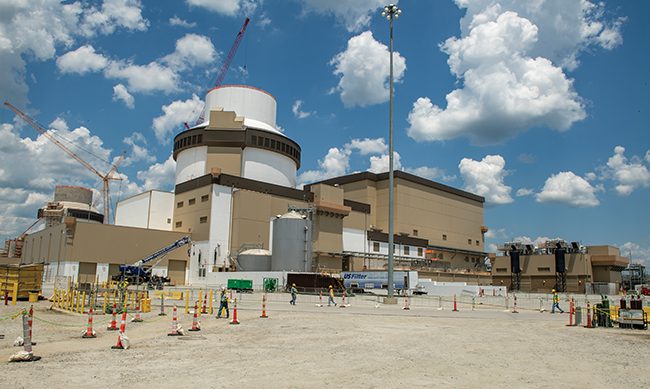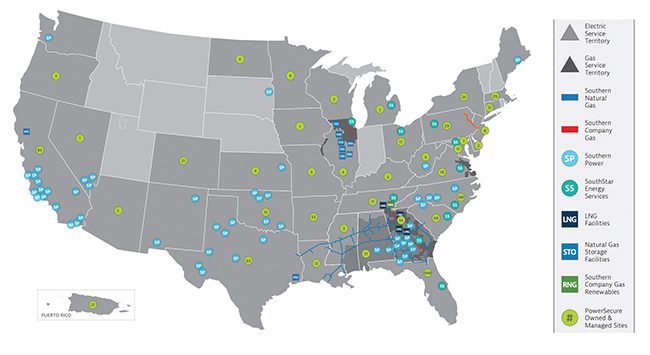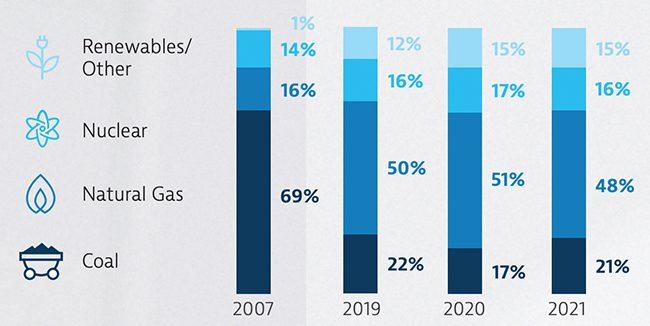Southern Company: A History of a Prolific Power Technology Pioneer
Credit to Author: Sonal Patel| Date: Mon, 01 Aug 2022 04:18:32 +0000

Atlanta-based energy giant Southern Co. has rapidly evolved to keep in step with the evolution of power. As part of its corporate growth, the company has notably pioneered technologies that have reshaped diverse fields, including those related to coal, natural gas, and nuclear.
The history of Southern Company, an Atlanta-based energy giant that has for seven decades fueled an elaborate economic engine that spans three Southeastern states, is often pinpointed to a single moment. It was in November 1911 when James Mitchell, a gifted engineer and a reputable developer of big projects, set sight on Cherokee Bluffs, a hard-to-reach point on the Tallapoosa River in Alabama. Mitchell’s vision was grand: to transfer the secluded site into a 40,000-acre lake and create the world’s largest artificial reservoir, and to follow that with a series of dams and powerhouses in other Alabama rivers. “He envisioned an electric supply system and a regional grid that could serve energy markets across the Southeast,” wrote Dub Taft and Sam Heys in their 2011–published chronicle Big Bets: Decisions and Leaders That Shaped Southern Company. “In essence, James Mitchell dreamed Southern Company.”
Mitchell’s dream quickly evolved into an initial holding company, Alabama Traction, Light & Power Co., which led to an organized evolution of a host of smaller energy companies, including Alabama Power. In the 1920s, Tom Martin, a southern lawyer, expanded that dream by replacing Alabama Traction, Light & Power Co. with a broader holding company, Southeastern Power & Light, and moved to acquire utilities in Alabama, Georgia, South Carolina, Mississippi, and Florida. That holding company was acquired by Commonwealth and Southern (C&S) in 1929. It endured a subsequent restructuring, which allowed the company to hold up during the Great Depression. But it also ushered in a period of profound influence and determination driven by Wendell L. Willkie, who became CEO and president of C&S in 1934. Willkie is credited for keeping C&S from financial ruin amidst a crumbling economy. Willkie, who would later run for U.S. president against Democrat Franklin Delano Roosevelt in 1940, also notably launched a stiff fight against the New Deal’s federally subsidized power and stood ground in a brutal legal fight to limit an expansion by the Tennessee Valley Authority.
After a series of divestitures that solidified its financial grounding, the Securities and Exchange Commission approved the formation of Southern Co. as the parent of Alabama Power, Georgia Power, Gulf Power, and Mississippi Power. Southern Co. continued its expansion during the post-war economic boom and in the 1970s despite financial turbulence (see sidebar “A Long History of Innovation”).
A Long History of InnovationSouthern Co.’s mission to economically and reliably meet soaring power demand has fueled its dramatic transformation into the diversified investor-owned giant it is today. To bolster post-war economic growth in the Southeast, Southern Co. doubled its power generating in the decade between 1947 and 1957, building more extensive and more efficient coal-fired power plants. After struggling to face challenges in keeping up with break-neck growth through the 1960s, it created a research department in 1969 to leverage rapidly evolving technological advances. The in-house effort to bolster innovation has driven the development of several pioneering technologies that the power world uses widely today. In the early 1970s, the company began developing solvent refining, a process for “cleaning” coal before combustion, and it also began research into advanced flue gas processing, including to develop scrubbers. In the aftermath of the oil crisis, it began a 500-kW solar-powered facility to evaluate the performance of solar on a large scale. In the 1980s, it tested methods to improve fly ash collection in electrostatic precipitators, completed the world’s first parabolic trough installation, and tested coal liquefaction and gasification. And in the 1990s, it hosted a 250-MW demonstration of low-nitrogen oxide burners at Plant Gaston, launched an electric vehicle research center, and tested microturbine technology. The drive for innovation has continued through the past 20 years. More prevalent projects include carbon capture tests at Plant Barry—including a more recent effort with GE to explore carbon capture, utilization, and storage for existing natural gas plants. On the nuclear front, Southern Co. has spearheaded testing of accident tolerant fuels and has partnered with TerraPower to design, construct, and operate the Molten Chloride Reactor Experiment (MCRE)—the world’s first critical fast-spectrum salt reactor. |
A Model for Resource Diversity
Today, Southern Co. is an Atlanta-based holding company that owns all outstanding common stock of three traditional vertically integrated state-regulated electric utilities—Alabama Power, Georgia Power, and Mississippi Power. Each operates public utility companies that provide electric service to retail customers in Alabama, Georgia, and Mississippi, and wholesale customers in the Southeast. The three utilities are part of the North American Electric Reliability Corp.’s SERC reliability region. Southern Co. is also notably part of a filing at the Federal Energy Regulatory Commission (FERC) proposing a Southeast Energy Exchange Market (SEEM). SEEM, expected to begin service in mid-2022, is an extension of the existing regional, bilateral market where participants will use an automated, intra-hour energy exchange to buy and sell power close to the time the energy is consumed, utilizing available unreserved transmission.
 |
1. Southern Co., a holding company, owns three traditional electric operating companies—Alabama Power, Georgia Power, and Mississippi Power, as well as various subsidiaries that span a diverse set of power business entities. Today, it has assets and interests all over the U.S. Courtesy: Southern Co. |
Beyond its utility businesses, Southern Co.’s many arms (Figure 1) encapsulate Southern Power, a major wholesale energy provider whose generation fleet totals about 12.4 GW. Another arm, Southern Nuclear, operates Southern Co.’s three nuclear power plants and is currently managing the construction of the Plant Vogtle expansion. Southern Co. holds Southern Company Gas, which is primarily a natural gas distributor but is also involved in gas pipeline investments and gas marketing services. Finally, Southern Co. also owns SCS, a system service company; Southern Linc, a provider of digital wireless communications; Southern Holdings, an intermediate holding company subsidiary that invests in various projects; and PowerSecure, which develops distributed energy and resilience solutions and deploys microgrids for commercial, industrial, governmental, and utility customers.
Combined, these subsidiaries own or operate 43,202 MW, including 30 hydroelectric generating stations, 24 fossil fuel generating stations, three nuclear plants (see sidebar “A Big Bet on New Nuclear”), 13 combined cycle/cogeneration plants, 45 solar facilities, 15 wind facilities, one fuel cell facility, and four battery storage facilities. The company lauds the diversity of its portfolio. “We are one of the only U.S. utilities pursuing an ‘all of the above’ net zero energy strategy,” it says. “Developing and maintaining a diversified energy portfolio is essential to successfully reducing emissions while also maintaining reliability and affordability for our customers.”
A Big Bet on New NuclearSouthern Co.’s long legacy of operating nuclear power plants began in 1975 with the completion of two units at the 1.8-GW Edwin I. Hatch Nuclear Plant near Baxley, Georgia. Alabama Power’s two-unit 1.8-GW Joseph M. Farley Nuclear Plant was completed in 1977, and a third plant, the two-unit 2.4-GW Alvin W. Vogtle Electric Generating Plant near Waynesboro, Georgia, began commercial operation in 1989. Southern Co. subsidiary Southern Nuclear operates all six nuclear units, which Southern Co. owns or co-owns with regional entities.
Anticipating a ramp up in regional demand, Southern Nuclear in 2006 began developing a two-unit expansion at Plant Vogtle (Vogtle 3 and 4), and construction kicked off in 2009, with plans to put the reactors online by 2016 and 2017. The two 1.1-GW AP1000 reactors (Figure 2)—the first new nuclear units built in the U.S. in the last three decades—are nearing completion. Southern Co. CEO Tom Fanning told investors in late May that Vogtle 3 nuclear fuel loading could occur in late summer, which would put it on track for an in-service date in either the fourth quarter of 2022 or first quarter of 2023. Unit 4 is projected to be complete in either the third or fourth quarter of 2023. Delays have reportedly pushed project costs up to at least $30.3 billion. Despite intense criticism about the third-generation nuclear plant’s construction, Southern Co. heralds the project as a crucial trailblazer. “I think it’s important for America as we think about transitioning to a net-zero future. As we think about ways to relentlessly reduce the amount of carbon in the atmosphere, we need nuclear,” Fanning said in May. “There is no better leader for nuclear in America today than Southern Co. And, in fact, it is a matter of national security. I’ve gotten tremendous support going all the way back to the Obama administration, the current administration, Donald Trump, and Congress to continue,” he said. “It’s a big deal, and we’re succeeding.” |
Assessing the Murky Path to Net Zero
Southern Co.’s most pervasive challenge, perhaps, could be to achieve a long-term greenhouse gas (GHG) emissions reduction goal to net-zero emissions by 2050, as announced in May 2020. The goal is a step up from a 2018 declaration that the company would seek an intermediate 50% reduction in GHG emission levels from 2007 levels by 2030 for its electric and gas operations. The 2018 goal, notably, made Southern Co. one of the first U.S. utilities to set a bold carbon-reduction goal.
“While environmental, social and governance (ESG) issues have received increasing attention by investors over the past few years, at Southern Co. these issues have always received the heightened attention they deserve,” Southern Co. Chairman, President, and CEO Tom Fanning said in 2020. “For us, focus on ESG issues and their alignment with long-term strategy and value creation is about far more than decarbonization. It goes to putting customers at the center of everything we do, building a sustainable workforce and making sure that the communities we serve are better off because we’re there,” he added. “This approach is embedded in our values and our DNA, and we know that it is the right way to drive long-term performance.”
 |
3. Southern Co. in 2020 laid out its technology options to achieve a long-term greenhouse gas (GHG) emissions reduction goal to net-zero emissions by 2050. This figure depicts a collection of established and emerging solutions that it said “could be useful” in decarbonizing its operations. Courtesy: Southern Co. |
In 2020, company executives said that Southern Co.’s “high-level” pathway to net-zero (Figure 3) would be comprised of several key elements. These include an “orderly transition” away from its coal fleet. The company views nuclear, hydropower, and natural gas as “foundational baseload, and flexible” components of the orderly transition. The company expects to expand its deployment of renewables and energy storage, modernize its power grid, and enhance energy efficiency programs.
However, its future mix could also be shaped by emerging technologies, though these will need support from a “suite of complementary policies” to support the acceleration of energy research and development (R&D), demonstration, and deployment “to enable solutions at equal or lower cost of service to energy customers compared to current conditions,” the company said in its 2020–published “Implementation and Action Toward Net Zero” report. Among emerging technologies the company deems “key” to achieving emission reduction goals are carbon capture, use, and storage (CCUS); renewable natural gas; advanced nuclear; and hydrogen. Finally, the company anticipates cultivating “negative carbon” concepts, such as natural gas solutions, biomass energy with carbon capture and utilization, and direct air capture.
Figures from 2021 suggest the company has made substantial progress. Compared to 2007, a year for which it cites total GHG emissions (based on equity share) of 157 million metric tons of CO2 -equivalent, in 2021, it recorded 82 million metric tons, which were estimated to be 47% below the 2007 benchmark level. While that figure “bounced up a little” compared to 2020 owing to soaring natural gas prices, the company says it is on track to achieve a 50% GHG emissions reduction no later than 2025.
Viably Replacing Coal’s Economic Engine
Environmental compliance—prominently of the federal Effluent Limitations Guidelines—are driving coal retirements at subsidiaries. By 2028, the company expects to have diminished the number of units in its coal fleet to eight, representing 4.4 GW. That’s a nearly 80% reduction in coal capacity compared to 2007, when the company held 66 coal units, a total capacity of 20.4 GW (Figure 4).
 |
4. Since 2007, the share of Southern Co.’s coal generation in its energy mix has declined from 69% to 21%. Its share of carbon-free sources has more than doubled—from 15% to 31%. Courtesy: Southern Co. |
In January 2022, Georgia Power proposed to retire and decertify 12 of its coal-fired units in Georgia—a total of 3.5 GW—by 2028. That covers its entire Georgia coal-fired fleet, with the exception of Plant Bowen Units 3 and 4, which it has planned to keep open until 2035, though the plant’s closure timeline could be decided by state regulators. Alabama Power, meanwhile, has sought to shutter or repower Plant Barry Unit 5, and all units at E.C. Gaston.
But shuttering a mass of iconic coal units has been challenging, Fanning acknowledged during Southern Co.’s Annual Shareholder Meeting on May 25. “As we close coal plants, we change the makeup of our business, and we do everything we can to ensure the employees are spoken for, that the communities are protected as well as we can.” Finding replacements for coal’s “economic engine” with potential improvements or enhancements has been equally rough, he said. A key question has been “Can we redeploy?” Fanning said. “Conceivably, could you put solar panels everywhere? Could you put combined cycle gas power conceivably? Could you put nuclear there now? Not on my watch, but probably in the [2030s], we will be faced with another decision, and that decision will be based on this kind of equation,” he said.
For now, the company is intently exploring natural gas with carbon capture. “We have to do something with the carbon coming off those plants,” Fanning said. “And we will evaluate the economics of that relative to what we call the ‘fourth-generation of nuclear,’ ” he said.
Beyond these sources, Southern Co.’s most practical pathway is to rely heavily on a solar expansion. “I am very bullish on solar,” he said. While Southern Co.’s operations are spread out nationwide, it lacks good wind resources, and must rely on resources transmitted from the Great Plains, he noted. However, a future embedded in renewables will require long-haul transmission or economic energy storage. “Let me be real with you, though,” he said. “I think there needs to be improvements in the material science around storage. The lithium-ion batteries of today, I would love to see something better in the future and the scale of storage required to support the kind of energy we’re going to deliver,” he said. “Recall, Southern Co. is about the size—a little bit smaller—from an energy production standpoint as the nation of Australia. If half of our energy is going to come from solar, we better have a whole lot of storage.”
—Sonal Patel is a POWER senior associate editor (@sonalcpatel, @POWERmagazine).
The post Southern Company: A History of a Prolific Power Technology Pioneer appeared first on POWER Magazine.